Nova Scotia’s population reached 1,000,000 in 2021, which was “a significant moment in our province’s history,” as premier Tim Houston says. Helping fuel this growth was the record-breaking number of 9,020 permanent residents who were welcomed to Nova Scotia in 2021. But those who have gone through the process of applying for a permanent resident permit know that number could have been higher, if only Canada’s immigration system was more efficient—and the Nova Scotian responsible for that system seems to agree.
“We live in the era of Netflix, our immigration system cannot use Blockbuster technology,” Central Nova MP and minister of immigration Sean Fraser says.
The tech issues that IRCC—the federal Immigration, Refugees and Citizenship Canada department—has to tackle are numerous and include long processing times, a slow and inefficient website platform, a short-staffed customer centre and relying on paper-based applications that take longer to process.

Two readers of The Coast shared their experiences with the process of applying for a permanent resident permit from the United States. Both situations were looking at the process of sponsoring an American spouse for Canadian residency.
Michel Pottier is a Nova Scotian married to an American. He tried to sponsor his wife in 2014, when processing time was 25 months. After 18 months, they gave up on the idea of living in Canada and went for plan B—applying for a green card, the symbol of permanent resident permission in the US, for Pottier. "I got my green card in one month," Pottier tells The Coast from his home in Portland, Maine, where he works in a university.
More recently, American Shelley Goulding had a different result dealing with IRCC. "Our experience went fairly smoothly once we submitted the application. From start to finish, it was roughly five months, which is pretty good," Goulding remembers.
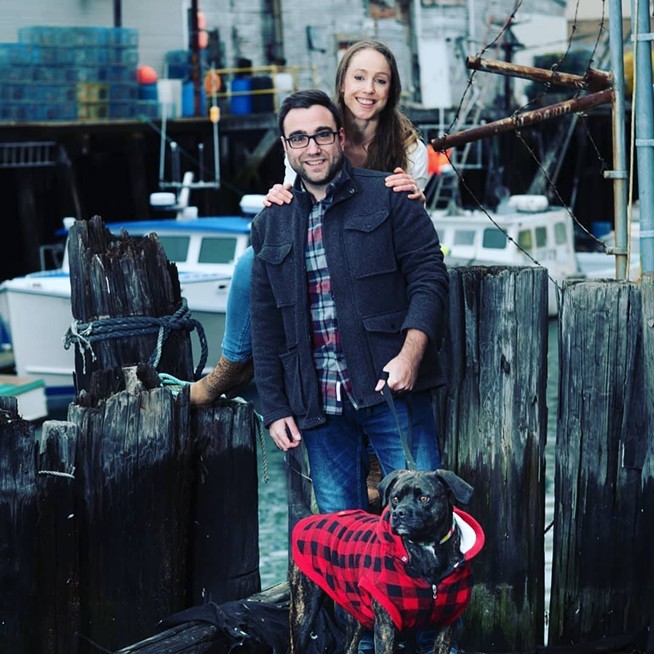
Minister Fraser is aware of the discrepancy between processing times announced on the website and the time experienced by applicants. As part of the modernization plans for the IRCC platform, Fraser says he wants “to give people better understanding of what the actual processing time is rather than broadcasting what the pre-pandemic standard was.”
The pandemic has been challenging for Canada’s immigration system.
Halifax immigration lawyer Lee Cohen says that in the past two years, anyone whose work involves any various form of bureaucracy has seen slowdowns due to COVID. “And that was understandable and acceptable a year ago, maybe a year and a half ago,” says Cohen. “But two years later COVID-19 in my opinion is now being used for the excuse for slow processing and poor response time from the immigration system, when in fact it is no longer COVID-19 that is the reason.”
Fraser knows what Cohen is talking about. “During the pandemic, we had to pivot our strategy to welcome more people who were already in Canada because our borders were closed, to protect their communities against the spread of COVID-19,” the minister says. “People who had applied, who were outside of Canada, their applications were not being processed as quickly because we knew that they couldn’t be welcomed here, and we didn’t want to have a paper of approval when a person couldn’t travel.”
Among those waiting for the borders to open were Carlos and Sophie Ballesteros, and their daughter Alice. The family had their luggage ready since February 2021, but only landed in Halifax a few weeks ago.
“It was really stressful,” Sophie remembers. “Every time we had the feeling that things were coming along, we had no answer. And whenever we contacted IRCC it was an automated email and it was so frustrating. We couldn’t know when we would arrive.”
When former IRCC minister Marco Mendicino was replaced by Fraser last October, the Ballesteros family opened a bottle of cava to celebrate. “We heard many lies before the elections, it was a constant lie,” says Carlos. The family welcomed Fraser’s new approach. “He said we need to stop new applications in order to clean the backlog. He was the first one to assume there was a problem."
IRCC recently hired 500 people and invested $85 million to reduce processing times for work permits, study permits, temporary residents visas, permanent residency cards and citizenship.
tweet this
After 25 years practicing immigration law in Canada, Cohen’s observation is that delays in the processing of applications were an issue before the pandemic that has gotten worse in the past two years. “The immigration system in Canada and at Canadian offices abroad has consistently failed to hire enough personnel to process the increasing amount of paperwork that needs to be processed in order for somebody to apply to immigrate to Canada and have that application processed in a reasonable time,” says Cohen.
The immigration minister is optimistic that can change. “We’ve been able to approve 100,000 applications in the first two months of 2022,” says Fraser. IRCC recently hired 500 people and invested $85 million to reduce processing times for work permits, study permits, temporary residents visas, permanent residency cards and citizenship.
The new investment also goes to a digital platform modernization. Between functionalities that are now available and features that will be online by this summer, it should speed up the existing process.
At its root, Cohen thinks Canada’s immigration system has a communications problem. “About 35 percent of communications that I receive from my existing clients has nothing to do with the substance of their application, and everything to do with how long is it going to take before this is done,” Cohen says.
To tackle this key issue, part of the IRCC digitalization plan is improving mobile applications where applicants can track their case, starting with a new permanent residency case tracker for family reunification applications that is already in place.
“If we can give people that information on their phone, whenever they wanted, in real time, and they have faith in what the phone is telling them,” Fraser says, “we are going to reduce the demand on the system and the staff will have a lot more time on their hands and will be able to process more cases more quickly.”
IRCC could follow the example of the Immigrant Services Association of Nova Scotia, which led the way for virtual delivery of services before the pandemic hit in March 2020. But ISANS chief executive officer Jennifer Watts warns “virtual delivery does not always work for everyone. Certainly people who have very beginner or no English language skills—and often have no experience of using digital technology—really struggle to engage.”
Recent permanent resident Goulding is among those hesitant of a fully digital transformation. “I would have security concerns. You are sending quite detailed personal information,” Goulding says. “And although we tried to block out account numbers and things like that, there is still just a lot of information in one place that someone could get their hands on.”
Fraser doesn’t have the same concern. “When you have a paper file floating in a mailroom, in an office, in another part of the world, you don’t know who is pulling that paper out, looking at it or taking a picture of a document,” he says. “I don’t know that this is happening in Canada’s immigration system, only to say that there are risks like that. We can put protections against that in a digital system that are more effective than protections that exist in a paper system.”
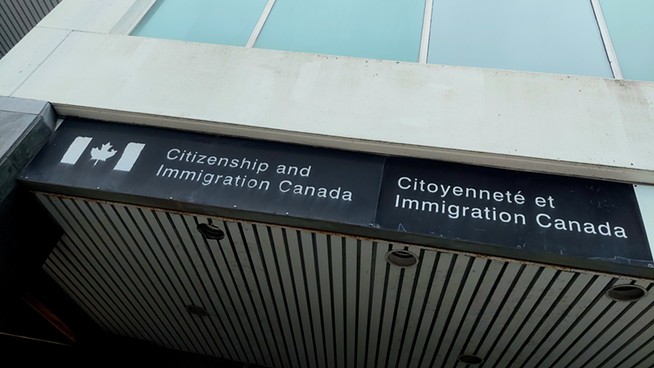
Permanent resident applicants living in Halifax sometimes wonder what the IRCC office at 1741 Brunswick Street is for. “They often tell you there are things they can’t do, they can’t access files even if they wanted to, so they are not very helpful,” says an essential worker in the waiting line for permanent resident status, who wishes to remain anonymous. “It would be good to have an actual office locally.”
In-person IRCC customer service doesn’t seem to have a place in Fraser’s digital vision. “The answer to me in the 21st century is not to build more buildings and fill them with more people,” he says, “when we can actually make the process more user-friendly with people who wanna use their phone.”
That said, Fraser was able to solve the mystery about what goes on in the Brunswick Street office. “The Halifax office does quite a few different things. Everything from in-person interviews to running the dedicated channels for the Atlantic Immigration Pilot, to processing different kinds of documents for people or for businesses,” he says.
“But it doesn’t have a roster of thousands of people to answer the phone when you call. Those calls are received through IRCC call centres that are more centralized.”
The file for the Ballesteros family is resolved now—they are permanent residents, soon to be moving to a new home in the Quinpool area. But they agree with minister Fraser on the need for a more digital approach on IRCC. “Today you can do everything online, it is not that complicated,” Carlos says.
Sophie has been working remotely for a marketing agency and Carlos is looking for a job opportunity in sales with the support of Halifax Partnerships’ Connector Program. All the stress and frustrations of the immigration process disappeared when they landed in Halifax.
“We felt so peaceful, so happy, it’s only positive things,” Sophie says. “We went for a walk on the waterfront and I had pain in my jaw because it was impossible to stop smiling. The city is amazing, everybody is super kind,” Carlos adds.
“A small price to pay for doing the right thing”
In the fall of 2021, all the messages submitted to the IRCC web form received an automated response stating that the department’s attention was on the Afghan refugees crisis: “In order to respond to a high volume of enquiries related to the crisis in Afghanistan, we have needed to shift resources in our Client Support Centre. This will impact our ability to respond to some of your enquiries.”
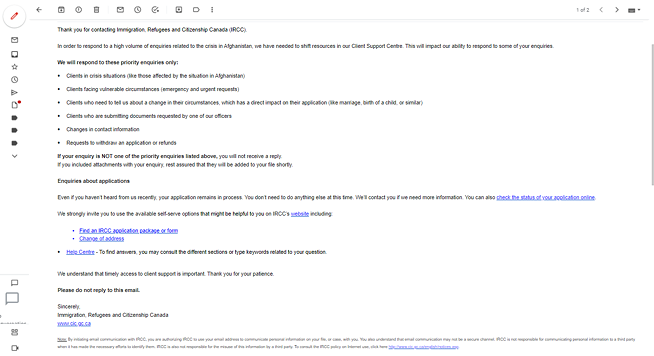
Fraser is aware of the inconveniences this had for all applicants. As the Russian attacks on Ukraine unfold and Canada prepares for a possible influx of Ukrainian refugees, he is hoping that IRCC has enough resources now, considering all the new staff hired, to respond to immigration inquiries from economic streams while also attending to the urgent humanitarian demands of asylum seekers.
“I expect whatever impact that this effort may have will be short lived, but given the scale of the atrocities in Ukraine, that is a small price to pay for doing the right thing,” minister Fraser says.
This sentiment is shared by other agents in the immigration process, like settlement agency ISANS.
“It is important to understand the need in our country to have people coming in with skills and experience to meet very critical labour market needs, but also to respond to our humanitarian commitments that we have,” says Watts. “Anything that is going to improve our system is absolutely important for us as a country, understanding what we need but also who we are.”
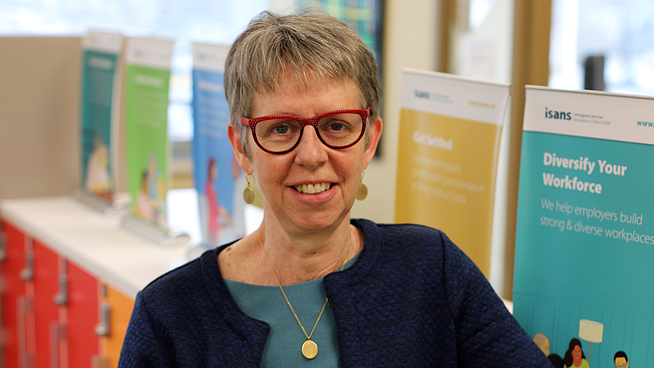
Federal minister Fraser also has the support of the provincial government. The minister of immigration in Nova Scotia, Jill Balser, is in close conversation with IRCC, and the Nova Scotia Office of Immigration has instructions to prioritize applications coming from Ukraine. “We want to make sure that we are in a process to fast track those applications,” says Balser.
But for those working in the Canadian immigration system, there is some discrepancy between what politicians say and the day-to-day reality.
“There is a bit of a disconnect, in the public messaging that Canada sends out to the world, particularly to the refugee community, and the countries from where refugees are being produced, and what actually happens on the ground,” Cohen says.
Ultimately, what happens on the ground is similar for both asylum seekers and economic migrants. “The process is mired on paper and in bureaucracy,” says Cohen. “There are too few people processing too much paper, and the rules and requirements that people have to meet are not rational.”
“The process is mired on paper and in bureaucracy. There are too few people processing too much paper, and the rules and requirements that people have to meet are not rational,” immigration lawyer Lee Cohen says.
tweet this
While the ambitious, fully digital and paper-free plans Fraser has for IRCC will, hopefully, resolve some of these bureaucratic issues in the current system, the way the immigration system in Canada is built still leaves people behind.
#StatusForAll so nobody is left behind
“There is systemic inequality within the system in different ways,” says Stacey Gomez, a member of the organization No One Is Illegal—Halifax/Kjipuktuk. “We have a racialized labour force that is coming to work on a temporary basis in this country, but they are systematically excluded from accessing permanent resident status, which is an expression of racism.”
NOII participates in a national campaign of the Migrant Rights Network calling for full and permanent immigration status for all migrants, including seasonal migrant workers, international students, refugees, asylum seekers and undocumented people.
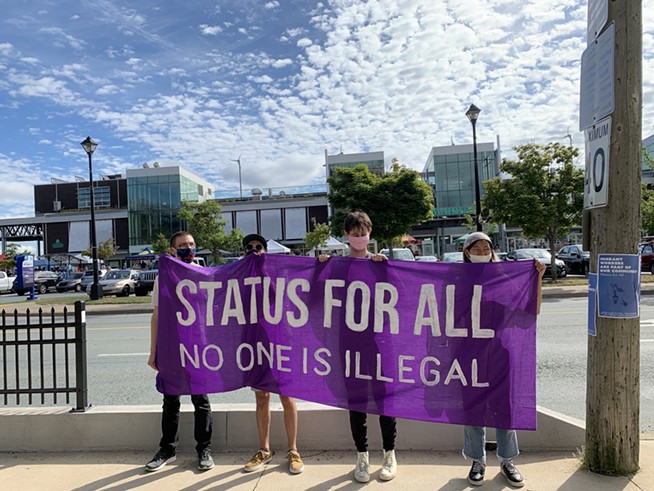
“There’s ways to make the system for processing more efficient, but the barriers are too great for becoming a permanent resident in this country,” Gomez says.
Seasonal migrant workers do essential work in Canada. They work in the food industry, often on farms and in fishing, and can be afraid to speak out against abuse from employers due to the closed work permits that allow them to work in Canada, but not change employers.
“They are not able to leave and if they speak out about an issue, like a pay issue or discrimination in the workplace,” Gomez says. “They risk being fired, probably returned to their home country. They also risk the ability to come back.”

Provincial minister Balser says these concerns are a priority for her department.
She welcomes any questions from employers to make their workplace more welcoming to these seasonal workers. “Employers play such a vital role in making sure that the workplaces are safe and welcoming and are adapting to the changing population that we are seeing in the province today,” Balser says.
She also says anyone working in Nova Scotia—foreign workers included—who faces any situation of discrimination or abuse is encouraged to call the government’s Labour Standards division at 1-888-315-0110 or email [email protected] with questions or concerns.
NOII recently tweeted out a news piece from OMNI Filipino, in Tagalog, about a group of eight temporary migrant workers who spoke out about workplace conditions at a lobster plant in Nova Scotia. The problems included lack of care or concern when they became COVID-19 positive, and being asked to complete duties outside of the scope of their contracts.
These workers were tied to their employer through a standard closed work permit, and only the support of NOII and other organizations, including the Philippine Consul General in Halifax, helped them find a way out of the situation. NOII says that six of the eight workers received a vulnerable worker open work permit, or VWOWP, that allows them to work elsewhere for up to one year. They all have ongoing Labour Standards complaints with the province.
Recently, eight Filipino migrant workers bravely spoke out about workplace conditions at a lobster plant in Nova Scotia #NSpoli
— No One Is Illegal – Halifax/Kjipuktuk (@NOII_HFX) March 8, 2022
To view the video in Tagalog, visit: https://t.co/6QAhXuKGPU
In NOII’s opinion, full and permanent immigration status for all migrant workers—in other words #statusforall—is what’s necessary to ensure they can leave abusive workplaces and access the same rights and essential services as others. "At best, VWOWPs are a stop gap," the organization says on a recent Twitter thread.
Digitalization and following the demands of the labour market seems to be what will be guiding the immigration system in Canada moving forward.
tweet this
In the past, seasonal migrant workers, even those who have been coming to Canada for over 10 years, hadn’t been eligible to become permanent residents in any of the current immigration streams. That changed in April 2021, when IRCC announced a new pathway to permanent residency for over 90,000 essential temporary workers and international graduates.
The demand, however, was greater than the three streams that were offered: 20,000 applications for temporary workers in health care, 30,000 applications for other selected essential occupations (including seasonal workers working in agriculture or the fishing industry) and 40,000 applications for international students recently graduated. On top of the high demand, many felt systematically excluded given the application requirements on these streams, particularly the English test.
When asked if new pathways will be in place for seasonal migrant workers to have an opportunity to apply for permanent resident status, both ministers of immigration share the same point of view: It will depend on what the labour demand tells them.
“The department is in a position to be able to make changes when they are needed. And we’ve seen that through the different sectors asking ‘can we bring workers here through different opportunities?’ and we have been able to respond,” provincial minister Balser says.
“There’s a lot of things that I’ve got planned. Some of them will reflect pandemic-related programs, and some of them will give flexibility that will allow us to implement the solutions that the circumstances demand, which might be a little different from the recovery phase of the pandemic than they were during the peak of the pandemic,” says federal minister Fraser.
“It is just important that we are always adapting and listening and making the processes better for everyone,” minister Balser concludes.
Digitalization and following the demands of the labour market seem to be guiding the immigration system in Canada moving forward. With the support of IRCC and settlement agencies like ISANS, Nova Scotia’s Office of Immigration also wants to have a strong focus on retention to help reach the province’s next ambitious population goal: two million people by 2060, with 25,000 newcomers per year.
“For folks that are choosing to come to Nova Scotia,” minister Balser says, “we really want them to stay.”















